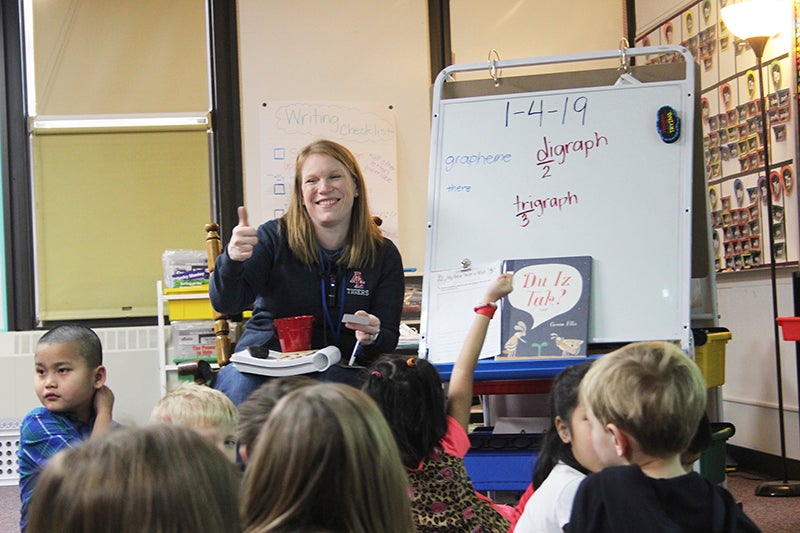Sound it out
Published 9:49 pm Tuesday, January 8, 2019

- Andrea Hollerud and her class give a student a thumbs-up after the student correctly pronounced a series of words during phonics time. - Sarah Kocher/Albert Lea Tribune
District focuses on phonics instruction to improve scores
A group of 17 first-graders fist up one hand and place that fist over their hearts.
“Rose,” Sibley Elementary School teacher Andrea Hollerud said. They move their fists from their chests to the space in front of their shoulders as the class says it together: “R — O — SE. Rose.”
The children count each distinct sound on one finger.
Rose is three phonemes, with a long O vowel phoneme. They know it’s a long O because “O says it’s name,” the first-graders said.
The Sibley first-graders — and all other elementary students in Albert Lea Area Schools — are in the thick of their first year with Really Great Reading, a phonics program implemented by the district to meet gaps in reading performance and understanding.
Phonics is a method of teaching that teaches about the relationship between sounds and the letters that make them. It’s all about putting letters with sounds, Hollerud said.
According to Mary Jo Dorman, executive director of teaching and learning for Albert Lea Area Schools, the district trained teachers how to use their phonics curriculum, but there was still a gap.
“The gap was, we needed to train teachers what phonics is,” she said. Really Great Reading’s teacher training is intended to address that.
“What we were seeing is holes,” said Sibley Elementary School Principal Diane Schultz. “… (Students) had phonics holes, which was affecting our reading scores. And so we’re making sure we’re trying to fill those holes (for) kids.”

Brooklyn VanRiper practices “look, think, say” during phonics instruction. Many portions of the Really Great Reading curriculum assign actions to learning moments. – Sarah Kocher/Albert Lea Tribune
The curriculum was implemented at the start of the school year. While Really Great Reading has curriculum for kindergarten through second grade, Schultz said the second-grade curriculum is used in classrooms up through fifth grade to catch older readers, too.
For students, the Really Great Reading curriculum is explicit, hands-on and rigorous, Hollerud said. Before, reading instruction took a more whole language approach, which is less about breaking down words and more about words themselves as units of language, and encouraging students to focus on word meaning.
Really Great Reading uses more labels — think phonemes, graphemes and trigraphs — all to help children improve their decoding: figuring out what a word is based on sounding out its parts. The goal is for this process to become automatic, and to improve phonics foundations to help with comprehension.
“Kids who have to use their brain power to decode so they don’t — they’re not automatic at it — they won’t be able to focus on comprehending what they’re reading because all their energy will go to into just trying to read the words on the page,” she said.
It’s also an aurally focused curriculum, she said. When the students are performing finger stretches — the activity in which they count out phonemes, or the smallest distinct unit of sound, on their fingers and identify vowel phonemes — they aren’t looking at anything instructional.
“It’s all auditory,” Hollerud said. “It should be all auditory first, before they are expected to identify letters and read words.”
How well the curriculum is working will be answered by time, Schultz said. Already, she and Hollerud are seeing gains, they said.
“I’ve just noticed the kids are more confident,” Hollerud said. Students will use methods they’ve learned during phonics instruction in their writing time, and their writing is better, she said.
“I think it’ll be really fun to see, honestly, like after having this a whole year, how much more they can do, because already we’re seeing a difference,” Hollerud said.
Still, the curriculum’s implementation is still in its infancy. If — and how — students are growing can be measured through diagnostic tests provided by Really Great Reading, which help break down and identify areas in which students may be struggling. According to Dorman, those diagnostic assessments are given out only to students whose performance on the district’s screening test, FAST, causes concern. Students take FAST assessments three times a year.
Dorman said teacher and student enthusiasm for understanding language has been fun to see.
“I think it’s because we’re really helping kids understand our language and reading, and just helping them to be good readers,” she said.


